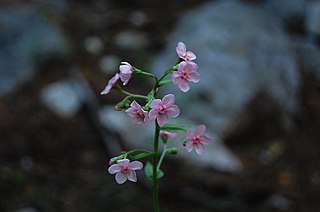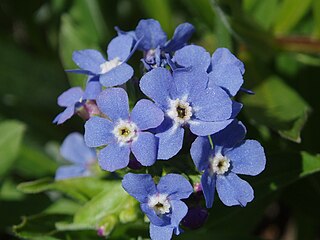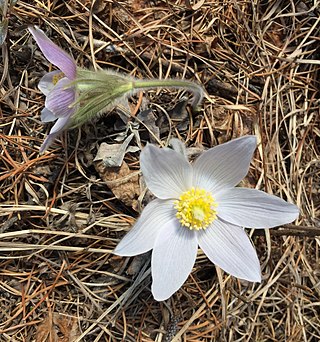
Hackelia (stickseeds) is a genus of plants in the borage family, Boraginaceae. It includes 54 species found in North America, western South America, temperate Eurasia, and Australia. 12 species are native to California.

Hackelia virginiana, a biennial plant, is commonly known as beggar's lice, sticktight or stickseed. However, the common names beggar's lice and stick-tight are also used for very different plants, such as Desmodium species that are also known as "tick-trefoil".

Erythronium americanum, the trout lily, yellow trout lily, or yellow dogtooth violet, is a species of perennial, colony forming, spring ephemeral flower native to North America and dwelling in woodland habitats. Within its range it is a very common and widespread species, especially in eastern North America. The common name "trout lily" refers to the appearance of its gray-green leaves mottled with brown or gray, which allegedly resemble the coloring of brook trout.
Hackelia bella is a species of flowering plant in the borage family known by the common name greater showy stickseed.

Hackelia californica is a species of flowering plant in the borage family known by the common name California stickseed.

Hackelia floribunda is a species of flowering plant in the borage family known by the common names large-flowered stickseed and manyflower stickseed.

Hackelia micrantha is a species of flowering plant in the borage family known by the common names Jessica sticktight and Jessica's stickseed.

Hackelia mundula is a species of flowering plant in the borage family known by the common name pink stickseed. It is native to the high mountains of California, especially the Sierra Nevada. Its range extends into Oregon. This is a lush, hairy perennial herb growing to maximum heights between 40 and 80 centimeters. It produces an array of erect stems with oval- or lance-shaped leaves most abundant around the bases, growing up to 22 centimeters long. The upper stems are mostly leafless and hold cyme inflorescences of flowers. Each petite flower has 5 rounded lobes which are light pink and age to light blue in color, each with a smaller petallike appendage at its base. The fruit is a small nutlet covered in thin, hairlike prickles.

Hackelia nervosa is a species of flowering plant in the borage family known by the common name Sierra stickseed. It is native to the mountains of California, especially the Sierra Nevada and its foothills, in areas with some moisture up to near treeline. Its range may extend into Nevada.

Hackelia velutina is a species of flowering plant in the borage family known by the common name velvet stickseed.
Hackelia amethystina is a species of flowering plant in the borage family known by the common name amethyst stickseed.
Hackelia brevicula is a species of flowering plant in the borage family known by the common name Poison Canyon stickseed.
Hackelia cusickii is a species of flowering plant in the borage family known by the common name Cusick's stickseed.
Hackelia setosa is a species of flowering plant in the borage family known by the common name bristly stickseed. It is native to the Klamath Mountains of northern California and southern Oregon, United States, and it is also known from Sierra Valley to the southeast of that range. It grows in open and wooded habitat. It is a hairy perennial herb up to about 60 centimeters tall. Most of the leaves are located around the base of the plant, reaching up to 22 centimeters long. Leaves higher on the stem are shorter and narrower. The hairy inflorescence is an open array of branches, each a coiling panicle of white-throated blue flowers. The fruit is a cluster of prickly nutlets.

Macaranga tanarius is a plant found in South East Asia, Thailand, Papua New Guinea, South China, Taiwan, and eastern Australia. It is commonly seen as a pioneer species in disturbed rainforest areas. Easily recognised for the round veiny leaves. In Australia it naturally occurs from the Richmond River, New South Wales to Cooktown in tropical Queensland.
Hackelia venusta is a rare species of flowering plant in the borage family known by the common name showy stickseed, or lesser showy stickseed. It is endemic to Washington state in the United States, where it is known from only one canyon in Chelan County. There is only one small population with a global distribution of less than one hectare. The plant was federally listed as an endangered species of the United States in 2002.

Pulsatilla nuttalliana, known as American pasqueflower, prairie pasqueflower, prairie crocus, or simply pasqueflower, is a flowering plant native to much of North America, from the western side of Lake Michigan, to northern Canada in the Northwest Territories, south to New Mexico in the southwestern United States. Pasqueflower is the provincial flower of Manitoba and the state flower of South Dakota.

Hackelia cronquistii is a species of flowering plant in the borage family known by the common name Cronquist's stickseed.

Verbena stricta, also known as hoary verbena or hoary vervain, is a small purple wildflower native to a large region of the central United States.

Lappula occidentalis, also known as flatspine stickseed, flatspine sheepburr, western stickseed, Lappula redowskii, or Redowski's stickseed, is a biennial forb native to North America and parts of Europe and Asia. It belongs to the family Boraginaceae. Variants include L. redowskii var. cupulata and L. redowskii var. redowskii, which differ in fruit morphology from the type specimen.














